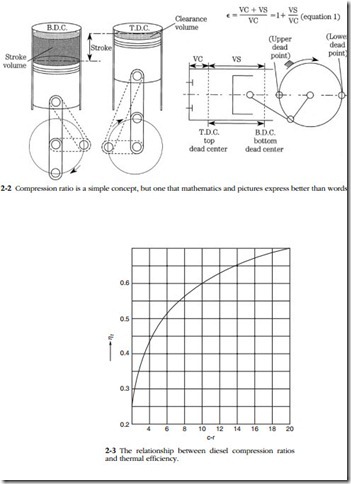At first glance, a diesel engine looks like a heavy-duty gasoline engine, minus spark plugs and ignition wiring (Fig. 2-1). Some manufacturers build compression ignition (CI) and spark ignition (SI) versions of the same engine. Caterpillar G3500 and G3600 SI natural-gas fueled engines are built on diesel frames and use the same blocks, crankshafts, heads, liners, and connecting rods.
But there are important differences between CI and SI engines that cut deeper than the mode of igniting the fuel.
When air is compressed, collisions between molecules produce heat that ignites the diesel fuel. The compression ratio (c/r) is the measure of how much the air is compressed (Fig. 2-2).
Compression ratio swept volume + clearance volume –: swept volume Swept volume the volume of the cylinder traversed by the piston in its travel from top dead center (tdc) to bottom dead center (bdc) Clearance volume combustion chamber volume Figure 2-3 graphs the relationship between c/r’s and thermal efficiency, which reaffirms what every mechanic knows: high c/r’s are a precondition for power and fuel economy.
At the very minimum, a diesel engine needs a c/r of about 16:1 for cold starting. Friction, which increases more rapidly than the power liberated by increases in com- pression, sets the upper limit at about 24:1. Other inhibiting factors are the energy required for cranking and the stresses produced by high power outputs. Diesels with c/r’s of 16 or 17:1 sometimes benefit from a point or two of higher compression. Starting becomes easier and less exhaust smoke is produced. An example is the
The relationship between diesel compression ratios and thermal efficiency.
Caterpillar 3208 that has a tendency to smoke and “wet stack,” that is, to saturate its exhaust system with unburned fuel. These problems can be alleviated with longer connecting rods that raise the compression ratio from 16.5:1 to 18.2:1.
It should be noted that a compressor, in the form of a turbocharger or super- charger, raises the effective c/r. Consequently, these engines have c/r’s of 16 or 17:1, which are just adequate for starting. Once the engine is running, the compressor pro- vides additional compression.
Gasoline engines have lower c/r’s—half or less—than CI engines. This is because the fuel detonates when exposed to the heat and pressure associated with higher c/r’s. Detonation is a kind of maverick combustion that occurs after normal ignition. The unburned fraction of the charge spontaneously explodes. This sudden rise in pressure can be heard as a rattle or, depending upon the natural frequency of the connecting rods, as a series of distinct pings. Uncontrolled detonation destroys crankshaft bearings and melts piston crowns.

